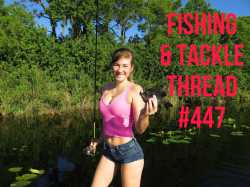>>2427171Fish only really hang out on structure so sunken trees, rock piles, overhanging vegetation are where you're going to be getting 90% of your bites. Bass aggressively slam lures so when you hear and feel your drag start to slip, quickly bend the rod to the left or right to set the hook in its mouth. Bass fishing is about covering as much water as possible, so unless you are reeling in, you should be moving constantly to search the water for fish.
Your basic baits are going to be topwater, midwater, and bottom baits.
Topwater are floating baits like frogs, spooks, and poppers. They attract the fish by disturbing the surface like an animal swimming across the water would. You are less likely to snag with these, but you are limited to just the fish hanging around near the surface.
Midwater are baits like crankbaits, spinnerbaits, and swimbaits. These cover a lot of ground and are the best for covering open water with little to no structure. These are often noisy and disruptive, so you'll sometimes trigger aggressive reflex bites from fish hitting the lure as soon as it comes by them. The downside with these is that they require a lot of straight water to really use them effectively.
Last are the bottom baits such as texas rigged soft plastics and jigs. These work by falling and bouncing along the bottom and are the best baits for working structure. These provide the most lifelike imitations of things that bass like to eat and they wiggle and sink like real creatures. The texas rig is arguably the best all around bass lure and can be fished in nearly all conditions. The downside is that these baits are the most quiet, so they have a limited range to which they are able to pull fish in, so they always have to be fished along the structure to work well. In addition, you're basically in the danger zone of being snagged 100% of the time you'rein the strike zone for these, so your accuracy and retrieval technique matters a lot.

